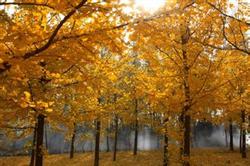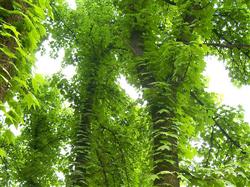Management of cultivation techniques of Ginkgo biloba in different time

From November to February of the following spring, shaping and pruning: the close planting of grafted seedlings adopts the natural shape of short stem. Seedling afforestation does not need plastic surgery. Ginkgo pruning is mainly to cut off withered branches, disease and insect branches, overdense branches, drooping branches and overlapping branches. Cut short and retract the old branches to promote the short branches at the cutting site to grow branches in order to cultivate new fruiting branches. Planting: the row spacing of grafted seedlings is 4 meters ⅹ 5 meters, and the seedlings are generally 5 meters ⅹ 6 meters or 7 meters ⅹ 8 meters. 20 male plants were planted as pollination trees. For long-term interplanting crops or other cash crops, the row spacing is mostly 8 meters, and the plant spacing is 4-5 meters. Planting on all sides can be planted in rows or scattered along roadsides, villages, canals and rivers. Using ginkgo biloba to plant courtyard trees in parks and factories can not only be ornamental, but also increase income. Planting hole 80 cm square, 60 cm deep, each hole applied organic fertilizer (garbage fertilizer, column fertilizer) 50 kg, plus 0.5 kg calcium superphosphate sand storage seeds and cuttings. Early spring fertilizer in March: big trees (such as seed production 50 kg) apply 100 kg rotten fence fertilizer or human feces and urine, 2 kg urea and 2 kg calcium superphosphate per plant. At this time, fertilization is applied to promote the formation of female flowers, flowering and seed setting and shoots. Generally, the seeds are sown by strip sowing, with a spacing of 20-25 cm, 8-10 cm between seeds, 60-70 kg per mu, and about 15000 seedlings emerge. The cuttings were collected from the hardwood of young trees under 10 years old and soaked in water for 16 hours. The survival rate of cuttings can reach 100%. The use of cutting to raise seedlings can not only maintain the excellent characters of the female parent, but also bear fruit earlier. There are two kinds of ginkgo biloba grafting: big rootstock grafting and small seedling grafting. The rootstocks grafted with small seedlings are generally 1-2-year-old seedlings, and the growth branches of 1-3-year-old scions are cut, and the thickness of the scion is similar to that of rootstocks, either by cutting, splitting, ventral grafting or subcutaneous branch grafting; small rootstocks can also be grafted by cutting buds (sticking buds), and the buds can also be cut buds that can be cut 2-3 years earlier. Large rootstocks can be grafted with large rootstocks of more than 5 years old or sterile trees. Generally use bark grafting or hypodermic branch grafting, the grafting site is 1.5-2 meters in the main stem of the rootstock, and the scion can be a large scion with 3-4-year-old short branches and a length of about 20 cm. It can bear fruit in the next 2-3 years, and the crown is also dwarfed. Prop up to support upright growth. Root tillers are often produced at the base of the trunk of Ginkgo biloba, which can be planted in early spring. Flowering and pollination in the first and middle of April: dioecious. The male plant is generally tall, the branching angle is small, and the crown is narrow. Most of the male flowers are inflorescences and pollen, so they should be collected at the right time, and the female plants should be granted full flowering period and evenly pollinated locally. Do not pollinate too much, resulting in too many fruits and years. There is a phenomenon of cutting down male plants in some areas, resulting in a shortage of pollen sources, so it is necessary to strengthen artificial pollination. Seed expansion fertilizer was applied from May to June, and the amount of fertilizer used was the same as that in early spring. Ploughing winter green manure, sowing summer green manure, there are Indonesian mung bean, black cowpea, pig dung bean and so on. When the crown coverage is less than 0.5, it can still be interplanted, such as peanuts, soybeans, broad beans, rape, ginger, cauliflower and so on. Summer weeding from July to August, covering the rhizosphere, or chemical weeding, such as glyphosate (265 grams for perennial weeds, 50 kg of water, 40-50 kg per mu), or 50 kg of trifluralin, 15 kg of water (for Monocotyledon weeds), 50-60 kg per mu. From late September to mid-October, this is the suitable time for seed harvest. The main fine varieties are: home Buddha finger (Taixing) Dongting Yellow (Taihu Lake Dongting Mountain area), Jinguo bergamot (Zhuji, Lin'an, Changxing), Damei kernel (Zhuji, Changxing, Lin'an, Fuyang), round fruit bergamot (Zhuji) and so on. The suitable time for seed collection is when the seed coat of Ginkgo biloba turns orange and a small amount of it falls off by itself. If the seed is harvested too early, the seed development is not complete, not only the yield is low, the quality is poor, the seed germination rate is low, so that the seed does not germinate. As the seeds are not easy to fall off, if struck with a bamboo pole, a large number of seed-bearing branches and leaves are often damaged, affecting photosynthesis after harvest and the yield of the following year. After the seeds are harvested, they can be spread out on the mat or on the indoor and outdoor flat ground and covered with straw. The spread thickness should not exceed 40 cm, and should not be watered or covered with soil, otherwise it is easy to get hot, or the seed coat is rotten unevenly, and the color of the seed shell is not white. When the seed coat is rotten, take out (Amoy) to remove the seed coat, wash it with clean water, and then spread it out for 2-3 hours to wait for the core and shell to shine. Never dry in the sun to prevent deterioration. Ginkgo seed coat is corrosive, it is best to wear rubber gloves when handling. While collecting seeds, collect fallen leaves and dry them in the sun. But it is not suitable to pick leaves in summer. Postharvest fertilization, 100 kg of fertilizer or garbage fertilizer per plant. Fertilization methods mostly take the tree champion as the center to dig circular ditches, pay attention to do not damage the main and lateral roots, 30 cm deep, the width depends on the number of fertilizers, fertilizer into the ditch, chemical fertilizer sprinkled on the organic fertilizer, and then cover the soil. The effect of irrigation or water supply is better after application. Sowing winter green manure: such as yellow alfalfa, purple vetch, big pod arrow tongue pea, Ziyunying and so on.
- Prev

How to plant Dichondra repens
How to plant Dichondra repens
- Next

High-yield cultivation techniques of Ginkgo biloba for leaves
1. Site selection of leaf ginkgo orchard requires flat terrain, good drainage and irrigation conditions, fertile loam or sandy loam, and it is not suitable to build leaf ginkgo orchard in saline-alkali land and mountain thin land. two。 Planting technology Ginkgo biloba orchard can be directly sowed or planted with seedlings or cuttings. The planting time is spring and autumn.
Related
- Fuxing push coffee new agricultural production and marketing class: lack of small-scale processing plants
- Jujube rice field leisure farm deep ploughing Yilan for five years to create a space for organic food and play
- Nongyu Farm-A trial of organic papaya for brave women with advanced technology
- Four points for attention in the prevention and control of diseases and insect pests of edible fungi
- How to add nutrient solution to Edible Fungi
- Is there any good way to control edible fungus mites?
- Open Inoculation Technology of Edible Fungi
- Is there any clever way to use fertilizer for edible fungus in winter?
- What agents are used to kill the pathogens of edible fungi in the mushroom shed?
- Rapid drying of Edible Fungi

